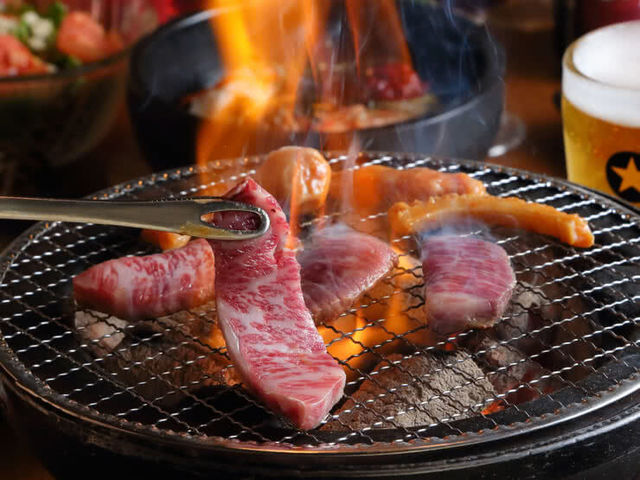Korean BBQ has taken the culinary world by storm, captivating the taste buds of food enthusiasts around the globe. Among the various dining experiences the Korean cuisine offers, the concept of all-you-can-eat Korean BBQ stands out as a delightful and immersive culinary adventure. In this gastronomic journey, patrons are not just diners but active participants, grilling an array of marinated meats at their table. Let’s delve into the unique and enticing world of all-you-can-eat Korean BBQ, exploring its origins, flavors, and the cultural significance that makes it an unmissable experience.
The Origins of Korean BBQ:
To truly appreciate the all-you-can-eat Korean BBQ phenomenon, it’s essential to understand its roots. Korean BBQ, as we know it today, has a rich history dating back to the Goguryeo era (37 BC – 668 AD). The tradition of grilling meat, particularly during festive occasions, evolved over centuries and eventually became an integral part of Korean culinary culture. The concept of all-you-can-eat Korean BBQ gained prominence in the latter half of the 20th century, with restaurants introducing the idea of unlimited servings to cater to the growing demand for this delectable dining experience.
The Dining Experience:
What sets all-you-can-eat Korean BBQ apart is the interactive and communal nature of the dining experience. Upon entering a Korean BBQ restaurant, patrons are greeted with the enticing aroma of sizzling meats and the rhythmic sounds of grills. Seated around a table fitted with a built-in grill, diners are provided with an extensive selection of marinated meats, including beef, pork, chicken, and sometimes seafood.
The process is simple yet engaging: diners choose their preferred cuts of meat, marinated in a variety of savory and sweet sauces, and grill them to perfection at their table. This hands-on approach not only allows for a customized cooking experience but also fosters a sense of camaraderie among diners as they share cooking tips and savor the freshly grilled delights together.
The Variety of Meats and Marinades:
One of the highlights of all-you-can-eat Korean BBQ is the diverse selection of meats and marinades available. From succulent bulgogi (marinated beef) to flavorful samgyeopsal (pork belly) and spicy dak galbi (marinated chicken), the options are seemingly endless. Each meat variety comes with its own unique marinade, often a well-guarded secret recipe passed down through generations. The marinades typically feature a harmonious blend of soy sauce, garlic, sesame oil, ginger, and various spices, creating a symphony of flavors that dance on the palate.
Accompanying the meats are an assortment of banchan, small side dishes that complement the BBQ experience. These can include kimchi (fermented vegetables), pickled radishes, and various seasoned vegetables, adding additional layers of taste and texture to the meal.
Cultural Significance:
Beyond its culinary appeal, all-you-can-eat Korean BBQ holds cultural significance in Korean society. It reflects the importance of communal dining and shared experiences, mirroring the traditional Korean values of togetherness and harmony. Families, friends, and even colleagues often gather around the grill, reinforcing social bonds while enjoying a delicious meal.
Moreover, the emphasis on grilling at the table highlights the value placed on freshness and immediacy in Korean cuisine. The direct involvement of diners in the cooking process ensures that each bite is savored at its peak, creating a dining experience that transcends the ordinary.
Evolution and Global Popularity:
In recent years, the all-you-can-eat Korean BBQ concept has undergone various adaptations to cater to diverse palates and preferences. Fusion variations incorporating global flavors, vegetarian options, and premium cuts of meat have emerged, appealing to a broader audience. The popularity of all-you-can-eat Korean BBQ has transcended cultural boundaries, with restaurants proliferating in major cities worldwide.
The interactive and social aspects of the dining experience make it an ideal choice for celebrations and gatherings. Whether it’s a casual night out with friends or a festive family reunion, all-you-can-eat Korean BBQ provides an immersive culinary journey that leaves a lasting impression.
Challenges and Innovations:
While the all-you-can-eat Korean BBQ trend continues to thrive, it is not without its challenges. Some establishments face the delicate balance of maintaining quality while offering unlimited servings, leading to variations in the dining experience. To address these concerns, many restaurants have embraced technology, incorporating automated grill systems, temperature-controlled settings, and digital ordering systems to enhance efficiency and consistency.
Additionally, the evolving landscape of dietary preferences has prompted innovations in the form of vegetarian and vegan-friendly options. Restaurants now offer a variety of plant-based proteins and creative marinades, ensuring that the all-you-can-eat Korean BBQ experience is inclusive and accessible to a broader audience.
Conclusion:
All-you-can-eat Korean BBQ is more than just a meal; it’s a culinary adventure that engages the senses and brings people together. From its humble origins rooted in tradition to its global popularity today, Korean BBQ continues to evolve while preserving the essence of communal dining and flavorful exploration. Whether you are a seasoned enthusiast or a first-time diner, the allure of grilling delectable meats at your table, surrounded by the laughter and chatter of fellow diners, makes all-you-can-eat Korean BBQ an irresistible experience that transcends cultural borders and culinary preferences. So, fire up the grill, embrace the sizzle, and indulge in the symphony of flavors that awaits at the heart of this culinary phenomenon.
-
What is All-You-Can-Eat Korean BBQ?
- All-You-Can-Eat Korean BBQ is a dining experience where patrons are offered unlimited servings of various marinated meats, including beef, pork, chicken, and sometimes seafood. Diners grill the meats at their table, creating a personalized and interactive culinary adventure.
-
How does All-You-Can-Eat Korean BBQ work?
- Upon entering a Korean BBQ restaurant, diners are seated around a table equipped with a built-in grill. They choose from a diverse selection of marinated meats and grill them to perfection at their table. The experience is communal, with patrons actively participating in the cooking process.
-
What types of meats are typically offered in All-You-Can-Eat Korean BBQ?
- The selection often includes beef (such as bulgogi), pork (like samgyeopsal or pork belly), chicken (dak galbi), and occasionally seafood. Each type of meat comes with its own unique marinade, offering a variety of flavors.
-
Are there vegetarian or vegan options available in All-You-Can-Eat Korean BBQ?
- Yes, many modern Korean BBQ restaurants offer vegetarian and vegan options, including plant-based proteins and creative vegetable-based dishes. It’s advisable to check with the restaurant beforehand to ensure they can accommodate dietary preferences.
-
What are Banchan in the context of Korean BBQ?
- Banchan refers to the small side dishes served alongside the main course in Korean cuisine. In the context of Korean BBQ, banchan includes items like kimchi, pickled radishes, and various seasoned vegetables, enhancing the overall dining experience.
-
Is All-You-Can-Eat Korean BBQ suitable for special occasions or group gatherings?
- Absolutely. All-You-Can-Eat Korean BBQ is a popular choice for special occasions, celebrations, and group gatherings. The communal aspect of grilling and sharing food makes it an ideal setting for socializing and creating memorable experiences.
-
Do I need to make a reservation for All-You-Can-Eat Korean BBQ?
- It’s recommended to make reservations, especially during peak hours or for larger groups. Some popular Korean BBQ establishments may have waiting lists, so booking in advance ensures a smoother dining experience.
-
Are there any time restrictions for All-You-Can-Eat Korean BBQ?
- Some restaurants may impose time limits, especially during busy periods. It’s advisable to check with the restaurant about any time restrictions and whether they apply to the all-you-can-eat experience.
-
How do I handle the grilling process if I’m unfamiliar with it?
- Korean BBQ restaurant staff are usually more than willing to assist beginners. They can guide you on grilling times, provide cooking tips, and ensure you have an enjoyable experience. Don’t hesitate to ask for help if needed.
-
Is there an age limit for All-You-Can-Eat Korean BBQ?
- Generally, there isn’t a specific age limit. However, pricing structures may vary for children, and some restaurants may offer discounts for younger diners. Check with the restaurant regarding their policies for children.
-
Are there any additional charges or hidden fees in All-You-Can-Eat Korean BBQ?
- While the concept is all-you-can-eat, it’s important to check if there are any additional charges for specific premium cuts of meat or supplementary items. This information is often provided on the menu or by the staff.
-
Can I take leftovers home from All-You-Can-Eat Korean BBQ?
- Policies regarding taking leftovers home may vary. Some establishments may charge extra for unconsumed food, while others may allow you to take home what you can’t finish. It’s best to inquire about the restaurant’s policy beforehand.
-
Do All-You-Can-Eat Korean BBQ restaurants accommodate dietary restrictions or allergies?
- Many Korean BBQ restaurants are willing to accommodate dietary restrictions or allergies. It’s advisable to inform the staff about any specific dietary needs when making a reservation or upon arrival, allowing them to make suitable arrangements.
-
Can I order drinks or desserts separately in All-You-Can-Eat Korean BBQ?
- Yes, most Korean BBQ establishments offer a range of beverages and desserts that can be ordered separately from the all-you-can-eat menu. This includes alcoholic and non-alcoholic drinks, as well as traditional Korean desserts.
-
Is tipping customary in All-You-Can-Eat Korean BBQ restaurants?
- Tipping practices vary by region, but it’s generally a common practice to leave a tip for good service. Check the local customs or inquire with the restaurant staff about their tipping policy.
-
What should I wear to All-You-Can-Eat Korean BBQ?
- The dress code is usually casual. As grilling is involved, it’s advisable to avoid overly formal or delicate clothing. Some restaurants provide aprons to protect clothing during the grilling process.
-
Are there cultural etiquette tips I should be aware of in All-You-Can-Eat Korean BBQ?
- It’s customary to wait for everyone to be served before beginning the meal. Additionally, it’s polite to offer to cook for others at the table and share in the communal experience. Respectful behavior and appreciation for the cuisine contribute to an enjoyable dining atmosphere.
Remember that specific details may vary from one Korean BBQ restaurant to another, so it’s always a good idea to check with the establishment directly for the most accurate and up-to-date information.








